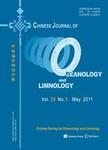Sea surface temperature anomalies in the South China Sea during mature phase of ENSO
Sea surface temperature anomalies in the South China Sea during mature phase of ENSO作者机构:Third Institute of OceanographyState Oceanic Administration
出 版 物:《Chinese Journal of Oceanology and Limnology》 (中国海洋湖沼学报(英文版))
年 卷 期:2016年第34卷第3期
页 面:577-584页
核心收录:
学科分类:0710[理学-生物学] 0908[农学-水产] 07[理学] 0707[理学-海洋科学] 070601[理学-气象学] 0815[工学-水利工程] 0706[理学-大气科学]
基 金:Supported by the National Natural Science Foundation of China(No.41306026) the Scientific Research Foundation of the Third Institute of Oceanography,SOA(No.2013009) the National Basic Research Program of China(973 Program)(No.2011CB403504) the National Special Research Fund for Non-Profit Marine Sector(No.201005005-2)
主 题:sea surface temperature (SST) anomalies E1 Nifio/Southern Oscillation (ENSO) South China Sea (SCS)
摘 要:Based on the 18-year (1993-2010) National Centers for Environmental Prediction optimum interpolation sea surface temperature (SST) and simple ocean data assimilation datasets, this study investigated the patterns of the SST anomalies (SSTAs) that occurred in the South China Sea (SCS) during the mature phase of the E1 Nifio/Southem Oscillation. The most dominant characteristic was that of the out- of-phase variation between southwestern and northeastern parts of the SCS, which was influenced primarily by the net surface heat flux and by horizontal thermal advection. The negative SSTA in the northeastern SCS was caused mainly by the loss of heat to the atmosphere and because of the cold-water advection from the western Pacific through the Luzon Strait during E1 Nifio episodes. Conversely, it was found that the anomalous large-scale atmospheric circulation and weakened western boundary current during E1 Nifio episodes led to the development of the positive SSTA in the southwestern SCS.



